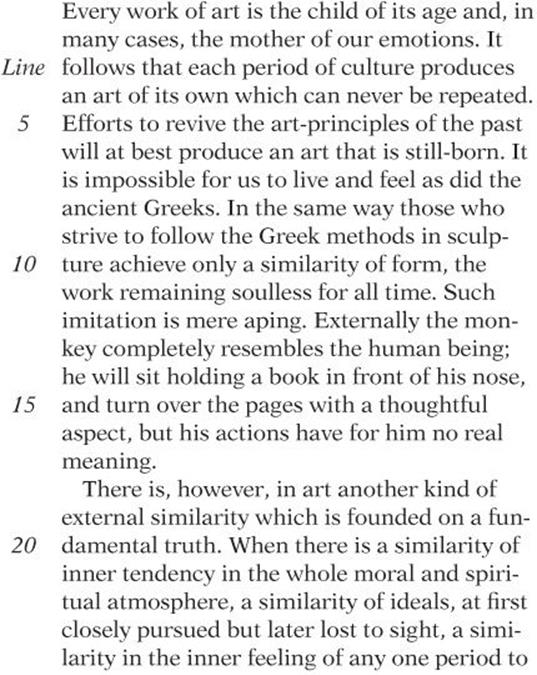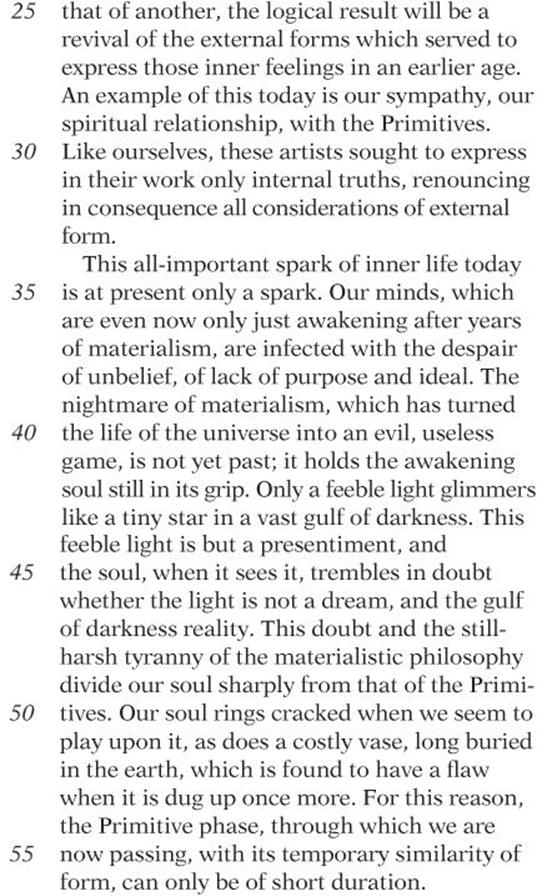SAT Test Prep
CHAPTER 4
CRITICAL READING SKILLS
Lesson 2: Analyzing the Purpose and Central Idea
Finding the Purpose
About 20–30% of SAT CR questions are “purpose” questions, such as “The overall purpose of this passage is to ….” or “The author refers to the “mountaintop” in line 6 in order to emphasize….” These questions ask why the author wrote the passage or used a particular word, phrase, or reference. You will always be prepared for these questions if you focus on overall purpose as you read.
SAT CR passages are drawn from a wide range of disciplines, but every passage has only one of three possible purposes:
• To examine a concept objectively. A passage that examines a concept is an analysis. It is strictly informative, like a newspaper article or a textbook passage. Think of it as a response to an essay question. It is objective—sticking to facts rather than opinions.
• To prove a point. A passage that proves a point is an argument. It presents the author”s point of view on a topic and explains why it is better than another point of view. It is subjective—a matter of opinion rather than fact.
• To tell a story. A passage that tells a story is a narrative—a piece of fiction, a biography, or a memoir. It describes how a character changes in order to deal with a conflict or problem.
To understand a passage, begin by asking, “Is this passage an analysis, an argument, or a narrative? Is its main purpose to inform to persuade, or to inform?” Knowing this makes answering many SAT questions easier.
Often, the introduction to the passage gives you clues about the purpose. Look for key words such as these:
• Analysis key words: examine, analyze, scientific, historical, explore
• Argument key words: comment, argue, opinion, perspective, point of view, position
• Narrative key words: biography, story, autobiography, memoir, novel, fiction, account
Finding the Central Idea
Often, the first question after an SAT passage is a “central idea” question such as “With which of the following statements would the author most likely agree?” or “This passage is primarily concerned with….” Knowing the central idea is critical to answering these questions. When you are given two “paired” passages, it is particularly important to know how their central ideas compare and contrast.
Although SAT passages contain lots of ideas, each has only one central idea. Find it. Every different type of prose has a different type of central idea.
• Every analysis focuses on a question that might interest a college professor. It might answer a question such as “What methods do scientists use to measure the location and intensity of earthquakes?” or “What were the social conditions of women in 19th-century England?”
• Every argument focuses on a thesis—the point the writer is trying to make. An argument takes a side and makes an evaluation. It argues against something substantial and doesn”t merely support a claim that everyone already agrees with. Too many students forget this. When reading an argument, ask “What substantial idea is this author arguing against?”
• Every narrative focuses on a conflict—the problem that the main character must deal with. There is no story without conflict—conflict drives the story. Basically, every story consists of (1) the introduction of the conflict, (2) the development of the conflict, and (3) the resolution of the conflict. Understanding a story begins with understanding this structure.
Once you discover the purpose of the passage, find its central idea—the question, the thesis, or the conflict. Underline it in the passage or jot it down in the margin. To make sure that you really have the central idea, check that it is supported by every paragraph. Often, students mistakenly think that the first idea in the passage must be the central idea. Not necessarily. For instance, an author may describe an opposing viewpoint before presenting his or her own, so his or her central idea doesn”t appear until the second or third paragraph.
Concept Review 2: Analyzing the Purpose and Central Idea
1. Name the three kinds of prose, and describe the purpose of each.
2. For each type of prose, name four “key words” in the introduction that indicate that particular type of prose:
a. Narrative
b. Argument
c. Analysis
3. What is the function of the “central idea” of a piece of prose?
4. The central idea of a narrative is the
5. The central idea of an argument is the
6. The central idea of an analysis is the
7. How do you know whether you”ve found the central idea of a passage?
8. After reading the passage on the next page, write what type of prose it is and its central idea.
SAT Practice 2: Analyzing the Purpose and the Central Idea
The following passage was written in 1911 by Wassily Kandinsky, a renowned abstract painter. Here he discusses the relationship between Primitivism, an artistic movement that seeks to move away from technology and the divisions of modern society, and Materialism, which denies that there is a spiritual component of reality.


1. Which of the following is the best title for this passage?
(A) The Art of the Early 20th Century
(B) The Dangers of Materialism
(C) Obstacles to the Revival of Primitive Art
(D) The Similarities in Artistic Movements
(E) The Lack of Purpose in Art
2. In context, the word “aspect” (line 16) most nearly means
(A) meaningful perspective
(B) facial expression
(C) configuration
(D) contemplation
(E) minor part
3. Which of the following is an example of the “fundamental truth” mentioned in lines 19–20?
(A) the inability of great artists like Vincent Van Gogh to achieve fame in their lifetimes
(B) the tendency of artists from all cultures to eschew social conventions
(C) the failure to reproduce artwork that was created in the fourth century BC.
(D) the ability of apes to create paintings that resemble abstract works by humans
(E) the similarity between two paintings created a century apart, each in the midst of a great class war
Wassily Kandinsky, Concerning the Spiritual in Art. © 1997 Dover Publications. Reprinted by permission of Dover Publications.
4. In saying that the soul “trembles in doubt” (line 45) when it sees the “feeble light” (line 44), the author suggests that
(A) artists have doubts about whether the era of materialism is truly past
(B) the public is unsure that its hunger for art will be met
(C) artists do not know from where their next inspiration will come
(D) the Primitives found mysterious lights more frightening than modern people do
(E) artists usually do not work well under the harsh light of scrutiny
5. How would the author characterize the effect of materialism on the artist”s soul?
(A) supportive
(B) confusing
(C) calming
(D) oppressive
(E) inspirational
6. According to the metaphor in the final paragraph, the “costly vase” (line 51) represents
(A) a materialistic aspiration
(B) a meticulously crafted piece of modern art
(C) an irretrievable frame of mind
(D) a cynical attempt at forgery
(E) a lack of purpose
Answer Key 2: Analyzing the Purpose and Central Idea
Concept Review 2
1. Narrative: to tell a story; argument: to persuade; analysis: to inform.
2. a. Narrative: biography, story, autobiography, memoir, novel, fiction, account
b. Argument: comment, argue, opinion, perspective, point of view, position
c. Analysis: examine, analyze, scientific, historical, explore
3. The central idea is the idea that focuses, organizes, and unifies the passage. Every paragraph must contribute to the central idea.
4. the conflict
5. the thesis
6. the question being analyzed
7. The central idea must “carry through” the entire passage, so to check that you”ve found the central idea, make sure that every paragraph contributes to that central idea. If not, then reread the paragraph until it “fits” with the central idea, or reconsider what the central idea is.
8. This passage is an argument; the author is presenting a subjective theory about art and artistic movements. Its central idea, or thesis, is summarized in lines 3–4: each period of culture produces an art of its own which can never be repeated.
SAT Practice 2
1. C The title should capture the central idea of the passage, which is the thesis that it is difficult to rekindle primitive art because all art is “a child of its age” (line 1) and because modern materialism is interfering with primitive impulses. The best title, then, is (C) Obstacles to the Revival of Primitive Art.
2. B The passage says that a monkey can look at a book with a “thoughtful aspect” but really have no understanding of the book. Since the monkey does not understand the book, choices (A) and (D) are illogical. The sentence is saying that the monkey only looks thoughtful, so choice (B) is the only sensible one.
3. E The “fundamental truth” described in the second paragraph is that a “revival of external forms” (line 26), that is, art forms that resemble those of the past, can occur only when there is “a similarity of inner tendency in the whole moral and spiritual atmosphere” (lines 20–22). The only example given that suggests that fact is (E).
4. A In these lines, the author is using a metaphor to describe how “our minds” and “the soul,” by which he means the artistic, spiritual mind, are affected by the materialism of the age. Artistic inspiration is described as a “spark,” and materialism as a “nightmare” and a “vast gulf of darkness.” The soul “trembles” because it doubts that the light is “not a dream,” meaning that the light might be a dream and the darkness reality. Therefore the author suggests that materialism might still hold the artistic soul in its grip.
5. D The metaphor in the final paragraph makes it clear that materialism “holds the awakening soul in its grip” (lines 41–42). This is not a nurturing grip, because the soul “trembles” (line 45) before the “nightmare of materialism” (line 39). Therefore, according to the author, materialism oppresses the artistic soul.
6. C The “costly vase” is described as something that has been “long buried in the earth, which is found to have a flaw when it is dug up once more” (lines 51–53). This vase is compared to “our soul” (line 50), which is described as having a “sympathy” (line 28) and “spiritual relationship” (line 29) with the primitives. Therefore, the costly vase clearly represents the irretrievable idea of primitivism.